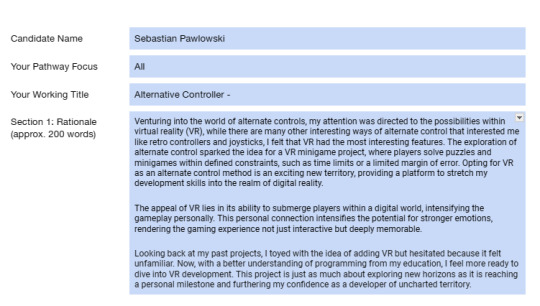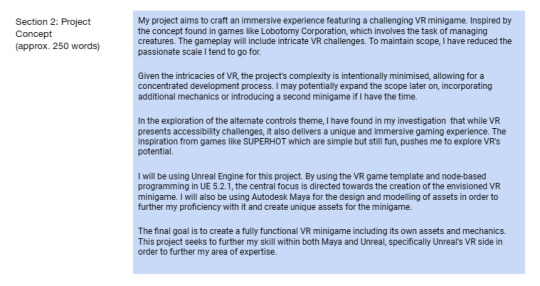Don't wanna be here? Send us removal request.
Text
Programming: Fuse box
Fuse Box
The fuse box works by generating 3 separate codes, one for each fuse slot, then spawning a bunch of dud fuses along with the right ones, after pulling the switch with all 3 correct fuses, the blackout ends.
Inside the Fuse box actor there are 3 place point actors, at begin play a reference is made for all 3 place points since they can't otherwise be referenced which was a big problem.

After the references, these 2 functions are run:

The set color codes function creates the 3 random codes for each slot in the same fashion as for the fuses, after which the set fuse lights function sets the color of all 12 lights in the box, 9 for the fuse slots and the 3 upper lights.
After that 3 fuses with the matching combo are spawned and manually attached in the fuse slots.

^ x3
Every tick many things are checked.

The Contains fuse lights logic checks the current fuses and sets the color of the upper lights, if there is no fuse placed, the light is red, if there is a fuse placed but it is not the correct one, the light is orange and if there is a fuse and it is correct the light is green and the success variable for that slot is set to true.
Next, the fuse box checks if a fuse has been ripped out while the puzzle is complete, if so, a spark occurs and a blackout is triggered.
Next, the logic for the lever and door is calculated, these two work in the exact same fashion as the lever to the door but along different axis.
Lastly the fuse box checks if the puzzle is complete, which allows the player to flick the lever to enable the power and end the blackout.
Also, when the door and lever are dropped their handle positions are reset so that they can be grabbed again.

The lever does different things depending on the conditions, it won't do anything if the puzzle isn't complete.

If the puzzle is complete, the result differs on conditions. If the lights are on, then flicking the lever will turn them off and turn on the red lights. If the lights are off and there is a blackout, it will end the blackout sequence, deleting the ominous figure, turning the lights on and ending the timer, otherwise it will simply reactivate the regular lights.

After this, the lever will slowly return to its regular position, during which it can't be grabbed.

Blackout sequence
The blackout sequence triggers the puzzle, disabling lights, spawning the ominous figure and starting the timer.
First, all fuses except the 3 inside the fuse box are deleted.

Next, all the needed variables are reset and a new color code is generated.

After which, all lights including fuse lights are turned off and after a short delay, the red lights activate, the timer starts (and spawns the ominous figure), the fuse colors are set and the place points reset their state.

Most importantly, for every place point, a correct fuse is spawned at a random preset location in the level marked with target points.

Lastly, the incorrect fuses (including faulty and fake fuses) are spawned, the door handle is launched open and a spark particle is spawned, followed by the fuses being launched out.

Overall I am deeply satisfied with how this whole system turned out, between not being able to properly communicate with child actors in the fuse box, the fuse's codes merging and resetting and the problems with creating the movable door and lever, there were many very minor complications which cost a lot of time when accumulated, however the whole system itself works flawlessly, even with multiple blackouts in a row and I consider it to be my most fleshed out mechanic yet.
0 notes
Text
Programming: Fuses and place points
The main mechanic is the fuse system which works with the fuse box made from a total of 5 actors.
Fuses
There are 3 fuse types total, though they all operate in basically the same way.
Every fuse has a code given to it on begin play consisting of 3 letters in any combination; R, G and B, these codes are then used to set the colors on the fuse. They also have custom events in order to recode them or recolor them.

Coloring the fuses works by setting the material of the 3 rings on the fuse mesh, the top, middle and bottom.

The coloring is done by taking the corresponding letter in the code by getting a substring, then using a switch on string node to set the ring to the correct material depending on the letter. This is done for all 3 rings.

^ x3
Place points
Place points are used to place objects into.
When a place point is created its mesh and material are set and a tag is added to identify what item can be placed in it.

When an object has been placed, it first goes invisible to prevent Z fighting.
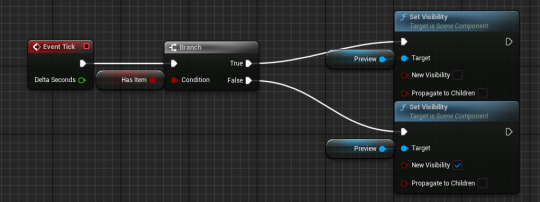
When a correct fuse is placed inside the place point, the place point inherits its code in order to later pass it on to the fuse box however it is also used to short circuit if a fake or faulty fuse is placed inside it, creating an explosion and turning out the lights temporarily.

When a fuse is dropped (or the attach event is triggered), it searches for place points that it is colliding with that have the Fuse tag,

when it finds an empty one, it triggers the fuse placed event with the explosive option on ticked and attaches itself to the place point.

When a fuse is grabbed and it is inside a place point, the place point will be cleared and lose the fuse's code.

The same thing happens when a fuse is launched out upon a blackout or when a fake or faulty fuse is placed in, along with an impulse being added to throw it.

A fuse can also be broken, which clears its code and makes its lights blink out and die, making it useless.
Fake/faulty fuse explosion

Fuses breaking

Faulty fuse
Faulty fuses work in the exact same way as regular ones with 2 exceptions.
Upon being placed in a place point, its explosive option is set to true, making it blow up.

2. It has a sequence which makes it constantly blink. This is done by randomly selecting which lights on it should be blinking on begin play.

Along with that, unlike in the regular fuse its colors are saved as variables. After doing so, this sequence is played on tick; for every blinking light there is a 10% chance to switch material to either a random color or no light.


Fake fuse
Fake fuses work similarly, but instead of blinking, they have different colors; Cyan, yellow and magenta, using some random chance to mix them in with the regular colors, but always with minimum one incorrect color in order to tell it apart, similar to the faulty fuse which always has at least 1 blinking light, they will also blow up.
Regular fuse on the left, fake on the right.

0 notes
Text
Programming: Door and lever
The lever is made using a system based off of this video:
youtube
The Lever works by rotating the lever scene based on the location of the grabbable component.
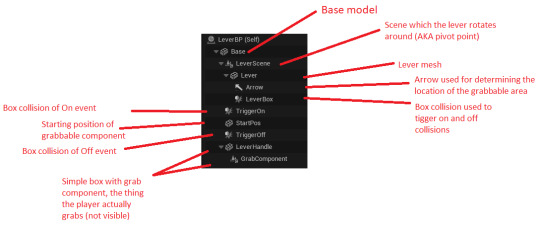


The lever opens and closes the door based on the two box collisions; TriggerOn and TriggerOff, these collisions fire events when the LeverBox box collision which is bound to the lever overlaps them, firing the correct event in the door blueprint.

When the lever is released, it snaps back to its original position by lerping between its current transform and its starting transform by using the StartPos static mesh.

In this case a variable isn't needed for the lever's current position since a violent snap is desired and it isn't needed for the start pos as it doesn't change location. Every tick it calculates its logic.
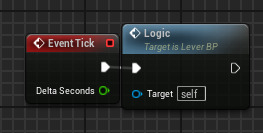
The logic works by comparing the distance between the grabbable component and the arrow (where the actual handle is) and setting the correct rotation,

Then snapping it to the on or off position if it is close enough.

The door works by utilizing 3 separate meshes, 2 invisible ones for the start and end position and the actual visible mesh which is lerped from the transform of one position to the other, while doing some calculations to ensure the door can be opened halfway through closing and vice versa.

Above the door is also a timer, which counts down from 60 seconds until the enemy attacks, its made by using a 3D widget component.
The start and end of the timer simply sets its opacity.
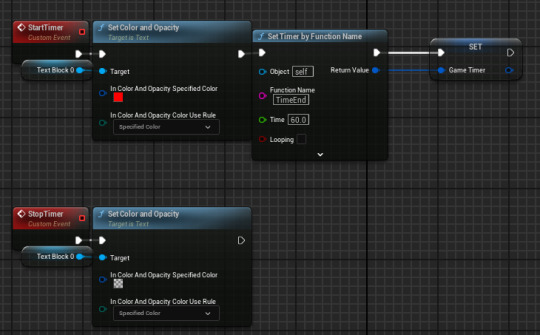
The timer uses calculations and the timer set at its start to output a remaining time in seconds and milliseconds.

As well as displaying a different message when it is finished.

Overall I'm pretty happy with how all of these work, they're all essentially without problems and work really well.
0 notes
Text
Programming: Ominous figure

The ominous figure is the threat during the game, after 60 seconds during a blackout, it will get up and kill the player.

In general the AI is pretty simple, after a delay of 60 seconds, it will readjust its location,

and start walking straight towards the player.

In front of it, it has a single box collision which checks for either the player or a door, if a player is found, a jumpscare is played.

The jumpscare simply works by setting the player's view to a different camera and ending their game.

Otherwise if it encounters a door, a special sequence is played. First, it is positioned in a certain spot behind the door and its movement (the first wire of the sequence node) is disabled.

Then, an animation is played both in the figure and the door, showing it forcing the door open and its movement is resumed.


(ignore timer video made while debugging)
The booleans used in the code tell the animation blueprint when to switch animations based on certain conditions.


Overall since its a simple blueprint there isn't too much that could've gone wrong. The only thing I'm unsatisfied is the jumpscare. Since this is a VR game, Its difficult to control where the player is looking and switching to another camera doesn't fix the problem, it is a temporary solution at most and I'd like to learn how to fix it in the future. Other than that there were little complications.
0 notes
Text
Programming: Folder and stamp
The folder and stamp are used in the gameover sequence where the player is supposed to hire a new employee to work in the room by stamping an application form.


The folder is a simple physics actor, all it does is play an opening animation when picked up and upon being dropped returns to its original position so that the player can't lose it.

This works simply by playing a premade animation, since one of the components is actually a skeleton mesh which allows it to do so.

In order for it to return to its original position, it sets a transform variable when it is created and by using the grab component, the "On dropped" event can be called. Using this event, the current transform is saved in a variable and the collision is disabled, then a timeline is played which sets the transform of the folder allowing it to smoothly go from its current transform to its original one, the reason a variable is used for the current transform is because grabbing the transform directly would change the transform while the folder moved which would give a very inconsistent result, instead a variable is set only once allowing for a smooth change from one to the other. Lastly the collision is re-enabled.

The stamp works in the exact same way, saving and changing the transform so that the player can't lose it.

The stamp itself is what actually restarts the level, by stamping the folder a decal is created and the level is loaded.

This works by using the spawn decal at location node which spawns the decal at the hit location of the stamp and an attach component to component node which attaches the newly made decal to the paper so that it can be moved.

After the decal is spawned, after a small delay the fade out effect plays and the main level is opened.
Since this was at the end of the project and I haven't used decals before, the actual decal is quite rushed, it doesn't rotate to the same rotation as the stamp and at certain angles its completely misaligned which makes me a bit unhappy with how it turned out but overall it works and the cosmetic change shouldn't be that hard to fix if the game would ever to be released.
0 notes
Text
APEX Event
Recently, I had the privilege of attending an enlightening event at Apex, where presenters from diverse fields shared their journeys into game design, breaking the conventional mold. As someone who is already immersed in and passionate about game design, the experience was both inspiring and thought-provoking.
What made the Apex event truly exceptional was the diverse range of speakers hailing from different professional backgrounds. From graphic designers to writers, and even textilers, each presenter shared their unique path into the world of game design. This diversity not only underscored the inclusive nature of the industry but also emphasized that there is no single, predetermined route to success in game design.
One recurring theme throughout the presentations was the idea that experiences from other fields are not just welcomed but actively valued in the game design industry. As someone who has already taken the plunge into game design, this was particularly heartening. It signifies that the skills and knowledge gained in other areas can serve as a valuable foundation for a successful transition into game development.
The stories shared at Apex highlighted a common thread – the breaking down of traditional barriers to entry in the game design realm. Many presenters spoke about how their passion for games, coupled with their existing skills, allowed them to contribute meaningfully to the industry. This resonated with me on a personal level, as it reinforced the notion that a genuine passion for game design can be a powerful catalyst, regardless of one's initial career trajectory.
As someone who is already deeply passionate about game design, the Apex event was a reaffirmation of the importance of pursuing one's passions wholeheartedly. The notion that the industry not only accepts but actively seeks out individuals with a fervor for game development provides a sense of optimism and encouragement for those, like me, who are already on this journey.
The insights gained from the Apex event have left an indelible mark on my perspective. The stories of those who ventured into game design from unexpected fields have inspired me to approach my own path with renewed vigor. It is a reminder that the industry values passion, creativity, and a willingness to learn, traits that I am eager to cultivate as I continue to navigate the exciting world of game design.
0 notes
Text
University of Suffolk
Recently, I had the exciting opportunity to attend a preview session at the University of Suffolk, where I delved deeper into the captivating world of game design. As someone with a burgeoning interest in the field, the experience left me both impressed and inspired.
One of the highlights of the visit was the in-depth look into the game design course offered by the University of Suffolk. What truly caught my attention was the comprehensive approach they take to teach not only Unreal Engine but also Unity. This dual focus on two of the industry's leading game development platforms interests me personally as someone who likes being skilled in many fields.
The Unreal Engine and Unity are powerhouse tools in the game development realm, each with its unique strengths. The fact that the University of Suffolk recognizes the importance of proficiency in both demonstrates their dedication to preparing students for a dynamic and ever-evolving industry which could help me grow.
During the preview, I had the chance to participate in some hands-on activities, gaining valuable insights into the practical aspects of game design. The well-equipped facilities and knowledgeable instructors guided us through the basics, making the complex concepts accessible and engaging. This emphasis on practical learning not only deepened my understanding of game design but also instilled confidence in my ability to navigate these powerful development platforms.
After this enlightening experience, I find myself considering the University of Suffolk as a prospective choice for my higher education journey should I ever decide to go into University. The combination of a comprehensive game design curriculum, and a focus on practical learning has positioned it as a strong contender in my list of potential universities.
Exploring the game design course at the University of Suffolk was a truly fantastic experience. The blend of theoretical knowledge and hands-on practice, coupled with the inclusion of both Unreal Engine and Unity, makes it a compelling option for anyone passionate about game development. As I contemplate my future academic opportunities, the University of Suffolk stands out as a place where I could not only learn but also thrive in the vibrant world of game design.
0 notes
Text
UE demo - Enhanced input system
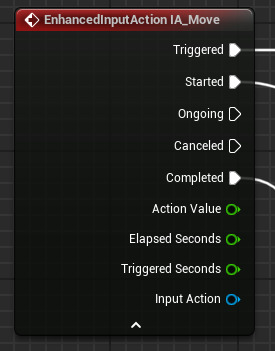
Triggered: The action has started, showing that all trigger requirements are met. For example, pressing and releasing a key triggers the action when the user lets go.
Started: Something happened to begin looking at triggers. For instance, the first press in a "Double tap" trigger starts the evaluation process.
Ongoing: The trigger is still happening. For example, with a "Press and hold" action, it's ongoing as long as the user keeps holding the button before a certain time. Depending on the triggers, this event will happen regularly while checking the action when it gets an input.
Completed: The process of checking triggers is finished.
Cancelled: The triggering process has stopped. For example, a user lets go of a button before a "Press and Hold" action can finish, cancelling the trigger.
Action value: changes depending on what kind of value is set to output, for example a float2d action value will return an X action value and Y action value. Usually 0-1.
Elapsed seconds: how long the input has been checked for including ongoing and started times, doesn't require trigger conditions to have been met.
Triggered seconds: how long the trigger conditions have been met.
Input action: a reference to the input being used.
The enhanced input system can be used in many ways, allowing for different responses on double tapping an input, holding an input, releasing an input etc. with the possibility of having multiple input mappings for a single input, allowing for a different response when a key is held or tapped.
An input map is made by creating input actions.

An input action decides what kind of value is outputted when it is triggered, in this case axis 1d is a 0-1 float, then a trigger is set, requiring for it to be activated in order to actually output the value eg. a hold trigger requires to be held. Lastly all modifiers are applied which alter the output value like dead zone which remaps all values within the set threshold from 0 to 1.
An input map is made of multiple input actions.

Input maps are used to assign which keys trigger the actions, along with giving their own triggers and modifiers.

Before being used in a blueprint, enhanced inputs need to be added as a mapping context

This way the inputs in the input mapping can be used in any blueprint, even as multiple events.

However that's not all advanced inputs are for, they can also be used for force feedback, or "rumble".

Force feedback can be used in order to vibrate most controllers, along with attenuation which can add falloff if force feedback is used on an object that isn't the player, meaning the rumble will get weaker the further you are from the object and attenuation source.
The curve represents the vibration the player will feel.

By using keys the curve can be adjusted and the intensity of the vibration over time will match the curve.

Any blueprint can play force feedback with the player controller reference available in most blueprints.

The effect can also be set to loop or pause a force feedback with an identical tag and play a new one.


0 notes
Text
UE demo- Grid based movement

This kind of movement works by reading the movement input and moving the character a set amount of distance every time it is triggered with a slight delay, however this method could lead to the character clipping through walls and out of the map, it is more efficient to use the snap to grid node.

A location is inputted and is rounded to the nearest position on the grid, with the grid points being all a set distance away from each other, which will also help with clipping.
0 notes
Text
Research - Grid based movement (GBM)
Grid-Based Movement in Board/Tabletop Games:
Chess:
Description: Chess is a two-player strategy board game that has been played for centuries. It features a grid with 64 squares, each player commanding an army with different pieces, each with unique movement rules. The goal is to checkmate the opponent's king.
Advantage of the Grid: The grid provides a clear and systematic structure for movement, contributing to the game's strategic depth. It enforces rules for each piece's unique abilities and limitations.
Grid Layout: The 8x8 square grid offers a balanced and symmetrical battlefield.
Effect on Actions/Interactions: The grid enables precise movements and calculated strategies, creating a rich and dynamic gameplay experience. The shape of the grid influences piece mobility and attack patterns.
Shape Impact on Gameplay: The rectangular shape contributes to the linear nature of chess, where pieces move orthogonally or diagonally. A different shape could alter movement dynamics and strategic possibilities.

Snakes and Ladders:
Description: Snakes and Ladders is a classic board game where players roll a die to move along a numbered grid. The game includes ladders that boost players forward and snakes that send them backward. The first to reach the final square wins.
Advantage of the Grid: The grid simplifies the movement system, emphasizing chance and unpredictability. It introduces an element of luck and excitement.
Grid Layout: A square grid with numbered squares.
Effect on Actions/Interactions: The linear progression along the grid, combined with the addition of snakes and ladders, creates an unpredictable and dynamic game.
Shape Impact on Gameplay: The straightforward layout of the grid contributes to the game's simplicity and accessibility, making it suitable for players of all ages.

Catan:
Description: Settlers of Catan is a popular board game where players establish settlements and cities on a hexagonal grid representing an island. The game involves resource management, trade, and strategic placement to achieve victory points.
Advantage of the Grid: The hexagonal grid introduces variety in resource distribution and fosters negotiation and strategic thinking. It allows for diverse and interesting board setups.
Grid Layout: A hexagonal grid with variable tile placement.
Effect on Actions/Interactions: Settlement and city placement depend on the hexagons, influencing resource collection, trade routes, and player interactions.
Shape Impact on Gameplay: The hexagonal shape allows for more natural connections and resource distribution compared to a square grid, promoting strategic and dynamic gameplay.

Grid-Based Movement in Video Games:
Standard Square Grid:
Final Fantasy Tactics:
Description: Final Fantasy Tactics is a tactical role-playing game where players command a group of characters on a grid-based battlefield. It features turn-based combat and job classes.
Implementation Reason: The square grid enhances tactical depth and precision in unit placement.
Grid Impact on Gameplay: Players must consider unit movement, attack ranges, and terrain advantages, fostering strategic decision-making.
Traversal: Characters move orthogonally, enhancing the turn-based tactical nature of the game.

Fire Emblem:
Description: Fire Emblem is a series of tactical role-playing games where players lead a group of characters in turn-based battles on a grid. Permadeath adds a layer of strategy, and the games often feature intricate storylines.
Implementation Reason: The grid system allows for tactical turn-based combat with defined unit positions.
Grid Impact on Gameplay: Shapes unit movement, engagement zones, and the importance of unit positioning in battle.
Traversal: Characters move orthogonally or diagonally based on their class and abilities.

XCOM 2:
Description: XCOM 2 is a turn-based tactical strategy game where players lead a resistance movement against an alien occupation. The game features square-based grid combat, base management, and strategic decision-making.
Implementation Reason: XCOM 2 employs a square grid to enhance the tactical depth of combat. The grid allows for precise positioning of squad members, cover management, and strategic use of abilities in the fight against alien forces.
Grid Impact on Gameplay: The square grid heavily influences the cover system, line-of-sight mechanics, and the effectiveness of different weapons. Players must strategically plan their moves within the confines of the grid to outmaneuver and defeat the alien threat.
Traversal: Characters move in an orthogonal manner on the square grid, emphasizing the importance of careful movement and positioning during encounters.

Isometric:
Diablo II:
Description: Diablo II is an action RPG set in a dark fantasy world. Players explore dungeons, defeat monsters, and collect loot in an isometric perspective. The game is known for its immersive atmosphere and addictive gameplay.
Implementation Reason: Isometric perspective enhances the immersive feel of dungeon exploration and combat.
Grid Impact on Gameplay: Enables precise movement and targeting in a visually engaging 3D environment.
Traversal: Characters move in eight directions, allowing for fluid exploration and engagement with enemies.

Fallout 2:
Description: Fallout 2 is a post-apocalyptic role-playing game set in an isometric world. Players navigate the wasteland, engage in turn-based combat, and make choices that impact the narrative.
Implementation Reason: The isometric grid provides a visually compelling representation of the post-apocalyptic world.
Grid Impact on Gameplay: Influences exploration, line-of-sight, and the interaction with the environment.
Traversal: Characters move in eight directions, allowing for versatile exploration and interaction.

SimCity 2000:
Description: SimCity 2000 is a city-building simulation game presented in an isometric view. Players plan and manage a city, balancing infrastructure, zoning, and citizen happiness.
Implementation Reason: Isometric perspective aids in visualizing and planning complex city layouts.
Grid Impact on Gameplay: Guides the placement of buildings, roads, and infrastructure in a visually cohesive manner.
Traversal: Buildings and roads are placed on an isometric grid, allowing for intricate and visually appealing city designs.

Hex-Based:
Battle Brothers:
Description: Battle Brothers is a turn-based strategy RPG set in a medieval-inspired open-world. The game features a hexagonal grid system for tactical combat scenarios, where players lead a mercenary company against various threats.
Implementation Reason: The hex grid is chosen to enhance the tactical depth of combat, providing a structured environment for positioning units and executing strategic maneuvers. It aligns with the game's focus on realistic and challenging battles in a medieval setting.
Grid Impact on Gameplay: Hexagons determine movement, attack ranges, and the positioning of units on the battlefield. The grid system adds complexity to engagements, requiring players to consider terrain, flanking, and unit abilities for successful outcomes.
Traversal: Units move across hexagonal tiles during battles, emphasizing the significance of the hex grid in shaping the flow and strategy of combat encounters in the game.

Civilization V:
Description: Civilization V is a critically acclaimed turn-based strategy game. Players lead a civilization from ancient to modern times, managing cities, diplomacy, and warfare on a hexagonal map.
Implementation Reason: Hexagonal grid offers more natural connections and strategic depth in global conquest.
Grid Impact on Gameplay: Influences city placement, territorial expansion, and resource distribution in a more organic way than a square grid.
Traversal: Units move on hexagonal tiles, shaping the strategic considerations for exploration and warfare.

Settlers of Catan (Digital Version):
Description: Settlers of Catan is a digital adaptation of the popular board game. Players trade, build settlements, and expand their influence on a hexagonal island to accumulate victory points.
Implementation Reason: Preserving the board game experience and emphasizing resource distribution.
Grid Impact on Gameplay: Influences the placement of settlements and roads, determining resource yields and trade routes.
Traversal: Settlements and roads are placed on hexagonal tiles, reflecting the strategic considerations of resource management and expansion.
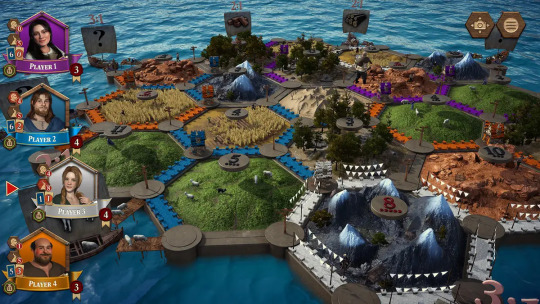
In summary, grid-based systems are fundamental components in both board/tabletop games and video games, profoundly influencing gameplay mechanics. Whether employing square grids in tactical games like XCOM 2 for precise combat positioning or hexagonal grids in Civilization V for strategic city planning, the grid's structured layout enhances player interaction, planning, and strategic decision-making. From classic board games like Chess to digital adaptations like Settlers of Catan, the advantages of grids are apparent, providing clarity, strategic depth, and a foundation for diverse gaming experiences across genres.
0 notes
Text
Research - Alternate controllers
Makey Makey:
Makey Makey is an invention kit that allows users to turn everyday objects into touchpads and connect them to a computer. It's a simple way to get started with physical computing and encourages creativity. For example, someone could turn bananas into a piano or use a pencil drawing to control a computer game. The Makey Makey kit includes a circuit board, alligator clips, and a USB cable.
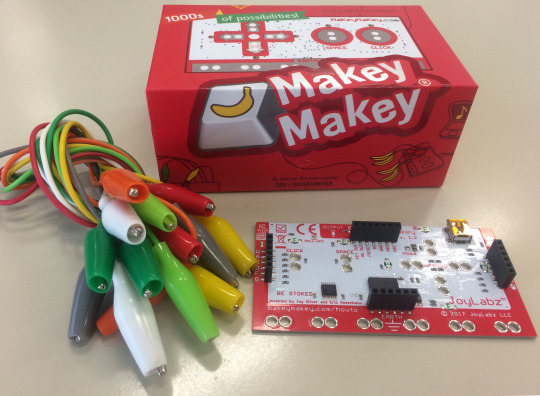
VR (Virtual Reality):
VR stands for Virtual Reality, which is a computer-generated simulation of a three-dimensional environment that can be interacted with in a seemingly real or physical way. VR games immerse players in a digital world, often using headsets and motion-tracking technology. VR Games:
"Beat Saber": This VR rhythm game brilliantly incorporates the immersive nature of virtual reality. Using motion controllers, players wield lightsabers to slash through incoming blocks, perfectly combining physical movement with musical precision. The 3D spatial awareness provided by VR adds a layer of challenge and excitement that wouldn't be possible with traditional gaming setups.

"Superhot VR": The time-manipulation mechanic in "Superhot VR" is a great use of VR technology. Time moves only when the player moves, allowing for strategic planning and precise execution of movements. This innovative approach turns the entire game world into a puzzle, taking full advantage of the player's physical presence in the virtual space.

"Half-Life: Alyx": This VR adaptation of the iconic Half-Life series not only brings players into the immersive environments of City 17 but also utilizes VR for intricate interactions. Players can physically pick up and manipulate objects, solve puzzles, and engage in intense combat scenarios. The game's success lies in how it seamlessly integrates VR mechanics into the narrative, enhancing the overall experience.

"The Elder Scrolls V: Skyrim VR": This VR adaptation of the open-world RPG allows players to explore the vast landscapes of Skyrim in an entirely new way. The sense of scale and presence in the virtual world is unparalleled, making players feel like they are truly traversing the rugged terrain, battling dragons, and engaging in epic quests with a level of immersion that traditional gaming cannot replicate.

"Boneworks": This VR first-person shooter is known for its groundbreaking physics system, which allows players to interact with the virtual environment in an incredibly realistic way. Objects have weight and can be used strategically in combat. The game's innovative use of VR extends to how players physically interact with weapons, climb surfaces, and manipulate objects. "Boneworks" showcases the potential of VR for creating immersive, physics-driven gameplay experiences that go beyond conventional gaming mechanics.

Motion Controls: The Nintendo Wii Remote, a pioneer in motion controls, enabled players to physically mimic in-game actions. In "Wii Sports," swinging the Wii Remote translated to actions like serving in tennis or hitting a golf ball.

The Nintendo Joy-Con Controllers for the Nintendo Switch provide an excellent example of motion controls. These compact controllers come with built-in accelerometers and gyroscopes, allowing them to detect motion and tilt. Games like "Nintendo Labo" utilize these motion controls for activities such as playing virtual musical instruments or controlling a virtual robot.

Xbox Kinect, a motion-sensing device, allowed players to interact with games using full-body movements. In "Just Dance," players follow on-screen dance moves, and the Kinect captures their motions, scoring their performance.

Retro controllers:
Controllers through the years have changed and adjusted to fit different consoles or even specific games, showing different ways of playing games throughout the times
NES Controller: The NES controller features a simple rectangular design with a D-pad and two buttons, emphasizing straightforward gameplay suitable for classic titles. The NES controller sits less comfortably in the hands from more modern designs.

Sega Genesis Controller: With a six-button layout, the Sega Genesis controller accommodates more complex inputs, particularly beneficial for fighting games like "Street Fighter II.". Like the NES it features a D-pad. The curved shape allows it to sit more comfortably in the hands and the six-button layout gives it more versatility for input.

Atari 2600 Joystick: The single-button joystick of the Atari 2600 is a hallmark of early gaming, emphasizing simplicity and precision for games of the time. With a comfortable grip this simplistic controller allows for simple gameplay.

SNES Controller: The SNES controller introduces shoulder buttons and a more ergonomic design, enhancing gameplay for titles that utilize more complex control schemes. Like its previous NES version, it is small and less comfortable to hold but sets up the button layout akin to more modern controllers.

Original PlayStation Controller: The original PlayStation controller introduces four face buttons and two shoulder buttons, along with a D-pad, setting the standard for future PlayStation controllers. Its unique design and button layout contribute to its nostalgic appeal.

These controllers vary in terms of the number of buttons, ergonomic comfort, and unique features, each catering to the gaming needs and technological constraints of their respective eras.
Mobile Platform Games:
Mobile games are less limited in the way they can be interacted with, allowing for multiple fingers to interact with games at once, but they also tend to steer towards more simplistic controls to appeal to younger audiences.
"Among Us": Mobile devices are the perfect platform for "Among Us" due to their touch control system. Players can easily navigate the map, complete tasks, and participate in discussions by tapping the screen. The game's success lies in its simplicity and its minigames, making it accessible to a wide audience while fostering social interactions within a virtual space. Though it has elements you can pay for, they do not have an effect on gameplay, being purely cosmetic

"Alto's Odyssey": The one-touch control system in "Alto's Odyssey" simplifies gameplay, allowing players to perform complex actions like jumps and tricks with a single tap. This minimalist approach to controls complements the serene and visually immersive experience of sandboarding through stunning landscapes. It showcases how mobile games can offer engaging experiences without the need for complex controls. It does not have pay for elements.

"Monument Valley": This puzzle-adventure game uses touch controls to manipulate the environment, shifting perspectives and altering pathways. The touch-based interactions are intuitive and enhance the player's connection with the game world. "Monument Valley" demonstrates how mobile platforms can provide unique and innovative puzzle-solving experiences through simple touch gestures and how a game doesn't necessarily need to control the player.

"Florence": This narrative-driven game uses touch controls to convey emotions and tell a story. Players engage with the narrative by interacting with elements on the screen, such as assembling puzzles to represent character relationships. The game's success lies in its ability to utilize the mobile platform for storytelling, using touch controls as a means of emotional expression.

"Crossy Road": Embracing the simplicity of mobile gameplay, "Crossy Road" challenges players to navigate a voxelated world filled with obstacles. The tap-and-hop mechanic makes it easy for players to pick up and play. The game's endless and progressively challenging nature showcases how mobile games can capture players' attention with straightforward yet addictive gameplay. Microtransactions are included, however there is no real advantage gained from its purchases and most things can be gotten for free with time

In general, these are but a few ways of alternate control, and many, more innovative ways of control exist, even without different special controllers.
0 notes
Text
Chocobo crystal hunt

Chocobo Crystal Hunt is an engaging card game with rules that shape its dynamic gameplay. Players aim to win by collecting six of the same crystal or all four different crystals, introducing a strategic balance. The players start with a big Chocobo and a crystal matching their token.
The three-card draw on the first turn sets a quick pace, ensuring players have early options to strategize. When obtained, on your turn Chocobos can be used to steal cards, until a big Chocobo (which must be returned) or a monster is drawn, then, the Chocobo is discarded unless it is a big Chocobo, fostering interactive gameplay and risk management. The constant availability of the big Chocobo, coupled with the draw-per-turn mechanic, ensures a continuous and unpredictable flow.
The draw-per-turn mechanic provides Chocobos, crystals, or monsters, adding a touch of randomness to the game. Stealing a monster comes with negative consequences, introducing a strategic element to card theft. Overall, the game's rules contribute to a fun and fast-paced experience, particularly enjoyable in multiplayer settings, making Chocobo Crystal Hunt a lively and strategic card game.
Top trumps (Harry Potter v)

In the Harry Potter version of Top Trumps, the game is played with a set of 30 cards dealt equally to all players. Each turn involves selecting the highest stat from the top card in a player's deck, and participants then compare this chosen stat on their respective top cards. The player with the highest stat wins the round and collects the opponent's cards, with the ultimate goal of acquiring all the cards.
A unique twist arises when the two best stats are matching or if two stats are unknown. In such cases, the cards are put on the table, then the player who wins the next round using the same stat continues to collect cards as usual, including those on the table.
As the game progresses, the tension builds when only two players remain. In this scenario, instead of giving cards to the opponent, the last two players discard cards. This adds a strategic element, forcing players to carefully consider their moves in the final stages of the game. Overall, the Harry Potter Top Trumps version combines card comparisons with a Harry Potter theme, offering a competitive and strategic experience for players.
Monopoly Deal

Monopoly Deal offers a strategic twist on the classic board game, emphasizing quick decision-making and clever card play.
The goal is to acquire three differently colored property sets, introducing a strategic layer by preventing the accumulation of two sets of the same color, for example, two sets of red cards, and a set of blue cards. A set is comprised of multiple property cards of the same color, with the required quantity specified on the property card.
Players begin with 5 cards each and draw 2 cards every turn, maintaining a steady flow of options. To prevent hoarding, if more than 7 cards remain at the end of a turn, players must discard down to 7 cards.
The game allows a maximum of 3 cards to be played per turn, with no minimum requirement. Property cards are strategically placed to activate rent cards and build sets. Using rent cards, players extract money from all opponents, the amount determined by the rent specified on the property card and the number of cards in the set.
Money cards are crucial for transactions, but players must play them to utilize their value; paying with cards in hand is not allowed. If a player lacks money, they must (and can only) pay with property, each having a designated price similar to money cards, paying with property means that the player must hand over their property, losing a part of a set to another player.
Action cards add a dynamic element, serving their stated effects or used as money. Players must choose one function per action card played. This dual use adds a layer of decision-making, as players must decide when to deploy action cards strategically.
Monopoly Deal combines property acquisition with resource management, offering a fast-paced and strategic card game experience with the essence of the classic Monopoly.
0 notes
Text
Research: Games for the impaired
Making Games Better for the Deaf and Hard of Hearing | Designing for Disability - YouTube:
Summary: In this video, I explored strategies to enhance the gaming experience for individuals who are deaf or hard of hearing. I found it fascinating to learn about innovative solutions for conveying game audio information visually or through vibrations. Discovering how game developers approach the challenge of inclusivity for the deaf and hard of hearing community was eye-opening.
Considerations for Future Projects: I'm considering incorporating subtitles, visual indicators, and customizable audio settings in games to ensure a more inclusive experience for players with hearing impairments. Exploring vibration-based feedback systems for conveying important auditory information could be a valuable addition to my projects.
Accessible Games: I'd recommend story-driven games with strong visual narratives, puzzle games, and strategy games as more accessible options. It's wise to avoid games that heavily rely on audio cues. A good example with lots of accessibility is "The Last of Us Part II".
Making Games Better for Gamers with Colourblindness & Low Vision | Designing for Disability - YouTube:
Summary: I delved into methods for making games more accessible to players with colorblindness and low vision. It was interesting to learn about the diverse ways colorblindness can impact gaming experiences and to discover creative design solutions addressing these challenges. Understanding how developers create visually appealing games for a broad range of visual abilities was surprising.
Considerations for Future Projects: I'm thinking about prioritizing clear visual design, offering customizable color options, and providing alternative means of conveying information (e.g., symbols, textures) in game design. Testing games with individuals with colorblindness and low vision to ensure accessibility is crucial.
Accessible Games: I'd recommend games with high contrast visuals, clear iconography, and customizable color schemes with the likes of "Celeste". It's advisable to avoid games heavily reliant on color-coded information.
Making Games Better for Players with Motor Disabilities | Designing for Disability - YouTube:
Summary: I explored ways to improve game accessibility for players with motor disabilities, covering features such as customizable controls, adaptive input methods, and simplified user interfaces. Discovering how developers design games to accommodate various input methods and control schemes for players with motor disabilities was fascinating. Learning about the impact of inclusive design on overall gameplay experiences was surprising.
Considerations for Future Projects: I'm considering implementing customizable controls, supporting a variety of input devices, and ensuring a simplified user interface for players with motor disabilities. It's crucial to consider the ergonomics of control schemes to prevent fatigue during extended gaming sessions.
Accessible Games: I'd recommend games with customizable controls, options for one-handed play, and those that allow for relaxed pacing like "Minecraft". I'd advise against games that require rapid and precise motor responses.
Improving Games for Those with Cognitive Disabilities | Designing for Disability - YouTube:
Summary: I explored strategies for enhancing game accessibility for individuals with cognitive disabilities, including clear instructions, simplified game mechanics, and options for adjusting difficulty levels. Understanding how developers address the cognitive diversity of players and create inclusive gaming experiences was intriguing. Discovering the impact of game design on cognitive load and engagement was surprising.
Considerations for Future Projects: I'm considering implementing clear instructions, providing options for adjusting difficulty levels, and avoiding overly complex game mechanics. Conducting user testing with individuals with cognitive disabilities to gather valuable feedback is something I'm planning to prioritize.
Accessible Games: I'd recommend games with straightforward mechanics, clear objectives, and customizable difficulty settings. It's wise to avoid games with convoluted rules or time-sensitive challenges, for example "Stardew Valley".
Exploring the nuances of making games accessible for individuals with diverse disabilities has underscored the vital role of inclusive design in the gaming landscape. The insights gained from considerations for the deaf and hard of hearing, those with colorblindness and low vision, motor disabilities, and cognitive impairments emphasize the need for flexibility and customization in game features. Learning from exemplary titles, I've come to appreciate the practical and inspiring innovations in accessible game design, ranging from subtitles and customizable controls to clear visual design. Moving forward, I recognize the imperative of integrating these lessons into future projects, ensuring accessibility becomes a foundational element of game development. The journey through these considerations affirms that designing for disability isn't merely about overcoming limitations; it's about fostering creativity, innovation, and building a gaming world that truly welcomes and includes everyone.
0 notes
Text
Initial Investigation - Alternate controllers
Motion and Full Body:
XR/VR/AR Controllers: These controllers are designed for immersive virtual, augmented, or mixed reality experiences. They often include motion tracking sensors and buttons. For example, the Oculus Touch controllers are equipped with thumbsticks, triggers, and capacitive sensors to detect finger movements. Popular game: "Beat Saber" where players wield lightsabers to slice through oncoming blocks to the beat of music.

Motion Controllers (Nintendo Switch or Wii): These controllers use motion sensors, accelerometers, and infrared technology to detect their position and orientation. In the case of the Nintendo Switch Joy-Cons, they can be attached to the Switch console or used independently. The movements of the player's hands are translated into in-game actions. The "Splatoon" series for the Switch allows players to aim their weapon by physically moving the Switch.

Xbox Kinect: The Kinect uses a depth-sensing camera and a microphone array to track the player's movements and voice. It can detect gestures, body position, and voice commands, enabling players to control games and applications without a physical controller. An example of this is "Dance Central" where players dance and mimic on-screen dance moves.

Handheld:
Mobile games with Gyro controls: Gyro controls rely on the gyroscope sensor in a mobile device to track its orientation and movements. Players can tilt or rotate the device to control in-game actions. A popular example is "Asphalt 9" where players tilt their smartphones to steer their vehicles in high-speed races.

Playdate - Crank operated games: The Playdate's unique feature is the crank located on the side of the device. Game developers can use this crank for various in-game actions. Cranking it clockwise, for instance, might move a character forward. For example "Crankin's Time Travel Adventure" allows players to control the character's time travel using the crank.
youtube
Nintendo DS - Dual Screens: The Nintendo DS features a stylus and a touch screen on the lower display, allowing players to interact with in-game elements directly. The upper screen displays the game's primary action. A popular game is "The Legend of Zelda: Phantom Hourglass" where players use the stylus to navigate and solve puzzles.
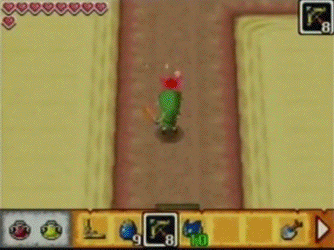
Game Specific:
Guitar Hero: The Guitar Hero controller consists of a neck with fret buttons and a strum bar. Players press the fret buttons and strum to match on-screen notes and rhythms.

Donkey Kong Bongos: These controllers are equipped with pressure-sensitive pads that detect claps and drumming. Players clap or drum to control in-game actions.
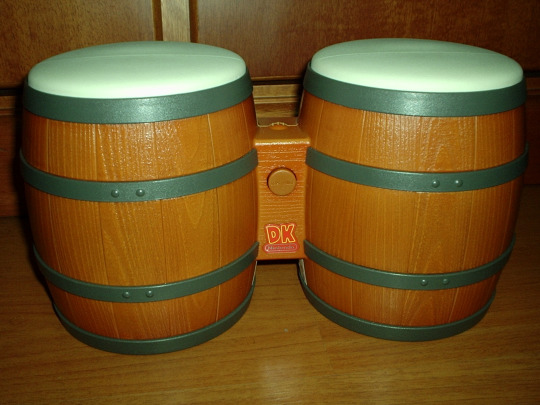
Buzz/Scene It (Xbox): These controllers are buzzers with buttons. Players use these to buzz in and answer trivia questions during quiz games.
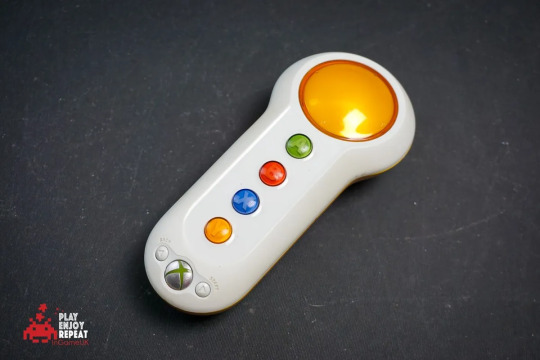
Dreamcast Sega Bass Fishing remote: This fishing controller resembles a fishing rod. Players reel in and cast their lines, mimicking real fishing actions in the game.

Pro-Gaming:
Pro-Gaming Pads - Custom Set-ups: Pro-gaming pads and custom set-ups are prevalent in professional esports, especially in games like first-person shooters (FPS) and real-time strategy (RTS). Players often use customized controllers, featuring programmable buttons, increased sensitivity, and ergonomic designs for quick and precise actions. Popular games in this realm include titles like "Call of Duty," "Counter-Strike: Global Offensive," and "StarCraft II." The custom set-ups are tailored to individual player preferences, allowing for optimal performance in competitive gaming environments.
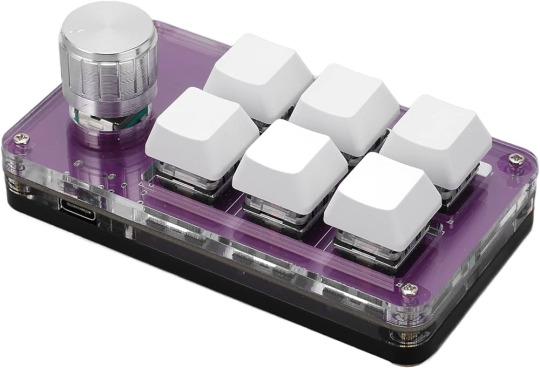
Joysticks: Joysticks have a rich history in gaming, especially in flight simulation and space combat games. Titles like "Microsoft Flight Simulator" and "Elite Dangerous" benefit from the precision and immersive control that joysticks offer. The unique range of motion allows players to maneuver aircraft and spacecraft with greater accuracy than traditional controllers. Joysticks are favored by enthusiasts seeking a more realistic and engaging gaming experience.

Steering Wheels/Rigs: Steering wheels and rigs are synonymous with racing simulations, offering a more immersive and realistic driving experience. Games like "Gran Turismo," "Forza Motorsport," and "Assetto Corsa" are popular titles where steering wheels are widely used. The force feedback and responsive controls provide a heightened sense of control and engagement, making them essential for serious racing game enthusiasts.

Retro:
Menacer (Sega Megadrive): The Menacer was a light gun for the Sega Megadrive, used primarily for games like "Lethal Enforcers" and "Body Count." It allowed players to aim and shoot on-screen targets, providing an arcade-like experience at home.
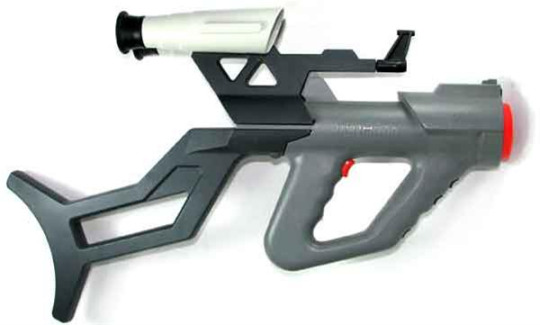
Zapper (NES): The Zapper was a light gun accessory for the NES, used prominently in games like "Duck Hunt." It relied on light sensing technology to register hits on targets, providing a unique and enjoyable gameplay experience.

Power Glove (NES): The Power Glove was a motion controller for the NES, attempting to translate hand movements into on-screen actions. While not widely successful, it remains an iconic piece of gaming history.
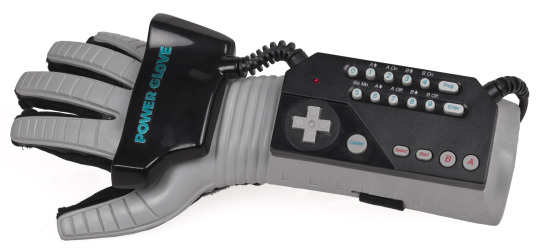
Jaguar (Atari): The Atari Jaguar featured a unique controller with a numeric keypad, designed to accommodate a variety of game genres. It was used for games like "Alien vs. Predator" and "Tempest 2000."
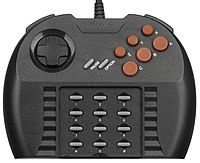
Arcade Games:
Racing Games: Arcade racing games, both traditional and unique, often use specialized controls such as steering wheels, pedals, and gear shifts. Classic titles like "Out Run" and modern adaptations like "Mario Kart Arcade GP" offer players a dynamic and immersive racing experience.
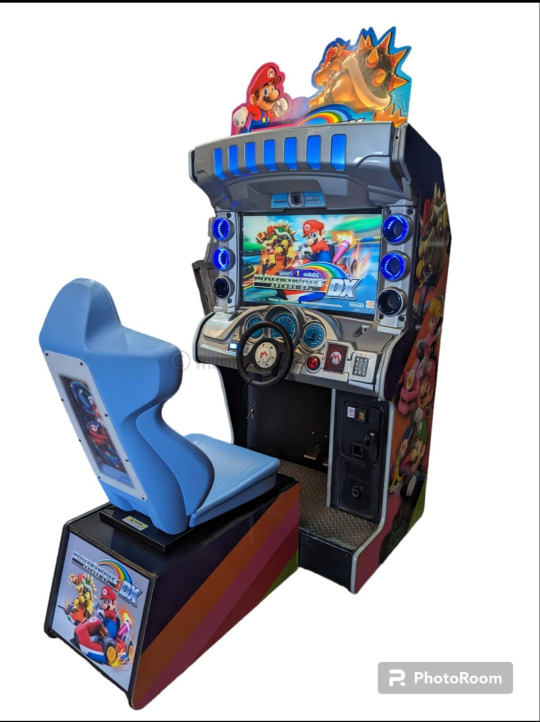
Gun Games: Arcade gun games like "Time Crisis," "House of the Dead," and "Terminator Salvation" utilize light guns, providing players with a realistic shooting experience. Unique features include reloading mechanics, cover systems, and force feedback, enhancing the arcade shooter experience.

Dance Dance Revolution: "Dance Dance Revolution" is a popular rhythm game that uses a dance pad. Players step on directional arrows in time with the music, offering a physically engaging and entertaining gameplay experience.

Tabletop and Physical Games:
Board Games: Board games encompass a vast range of genres, from classic titles like "Monopoly" and "Scrabble" to modern strategy games like "Catan" and "Ticket to Ride." These games often involve a combination of cards, dice, and tokens, providing a tactile and social gaming experience.

Card Games: Card games, whether traditional like "Poker" or modern deck-building games like "Dominion," rely on strategic play and often involve social interaction. They are versatile and enjoyed by players of all ages.
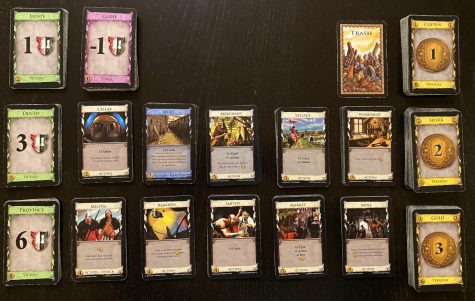
RPG’s (Dungeons & Dragons): Role-playing games (RPGs) like "Dungeons & Dragons" (D&D) involve a combination of storytelling, dice rolling, and character development. Players use rulebooks, character sheets, and dice to navigate imaginary worlds and embark on epic adventures.
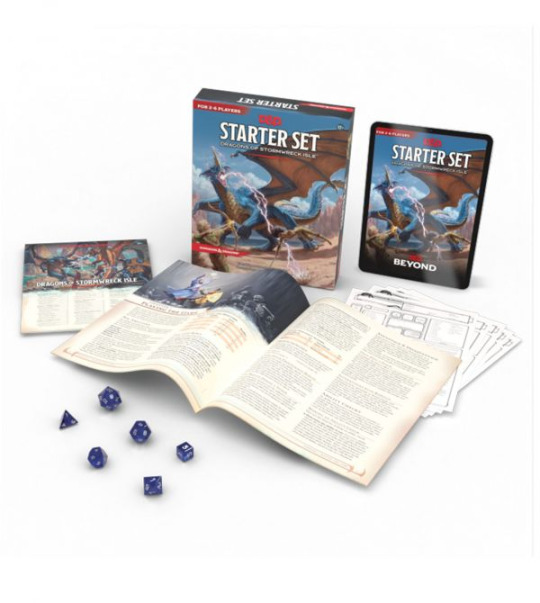
LARP’ing: Live-action role-playing (LARPing) takes gaming into the real world, where participants physically portray characters and engage in a shared narrative. LARPing often involves costumes, props, and immersive environments, blurring the lines between tabletop gaming and theatrical performance.

Fairground Games:
Coconut Shy: Traditional fairground games like Coconut Shy challenge players' skills in a carnival setting. Players attempt to knock over coconuts with thrown balls, showcasing a mix of precision and luck.

Other:
Quiz Games - Jackbox Games: Jackbox Games revolutionized party gaming by using mobile devices as controllers. Games like "Quiplash" and "Fibbage" involve answering trivia and creating humorous responses, making them accessible and entertaining for diverse player groups.

Dragon Quest's Nintendo Switch Slime Controller: The Nintendo Switch Slime Controller, inspired by the "Dragon Quest" series, features a unique design resembling the iconic Slime monster. While not altering gameplay mechanics, it adds a thematic and playful element to the gaming experience.

Now Play This – A Festival of Experimental Game Design: "Now Play This" is a festival that showcases experimental and unconventional game designs, pushing the boundaries of traditional gaming
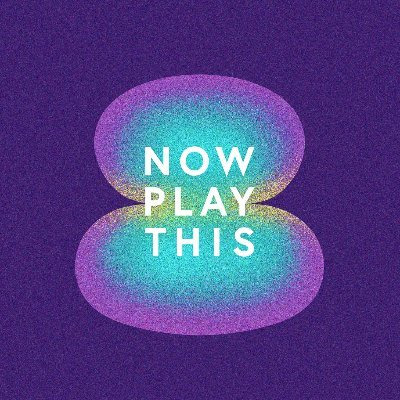
Alternative controllers are not just a means to diversify gameplay experiences; they are powerful tools in fostering inclusivity within the gaming community. These controllers, whether they involve motion sensing, unique peripherals, or adaptive input devices, offer a pathway for individuals with disabilities to engage in the world of gaming. They redefine the boundaries of accessibility, making it possible for gamers of all abilities to participate fully and experience the joy of interactive entertainment. By tailoring gameplay experiences to different needs, alternative controllers play a pivotal role in ensuring that gaming transcends physical limitations, allowing everyone to share in the immersive and rewarding world of video games.
0 notes
Text
Research: EGX trip
For this project I had attended the EGX games event, and though I didn't take any pictures there were still some fascinating things.
Attending the EGX London Games event was a revelation for me, as it opened my eyes to the diverse world of gaming beyond traditional keyboard and controller setups. The event showcased a plethora of alternate controllers, challenging the notion that these two options were the sole means of interaction with games.
Exploring the exhibition hall, I encountered a fascinating array of innovative and unconventional gaming peripherals. From motion-sensing devices like VR to custom-built controllers like Flight simulator joysticks, steering rigs and even a custom sonic themed button reflex machine, each setup offered a unique and immersive way to engage with video games. It was evident that developers and enthusiasts were pushing the boundaries of conventional gaming, creating experiences that extended beyond the familiar realms of keyboards and controllers.
One noteworthy aspect of the event was the emphasis on inclusivity and accessibility. Alternate controllers were designed with a variety of users in mind, catering to different abilities and preferences. This approach not only broadened the gaming community but also highlighted the importance of accommodating diverse needs.
Experiencing these alternate controllers firsthand allowed me to appreciate the creativity and thoughtfulness behind their designs. The tactile feedback and unconventional input methods added a layer of immersion that I had not previously considered. It became clear that gaming could be a dynamic and adaptable experience, tailored to individual preferences and playstyles.
0 notes



